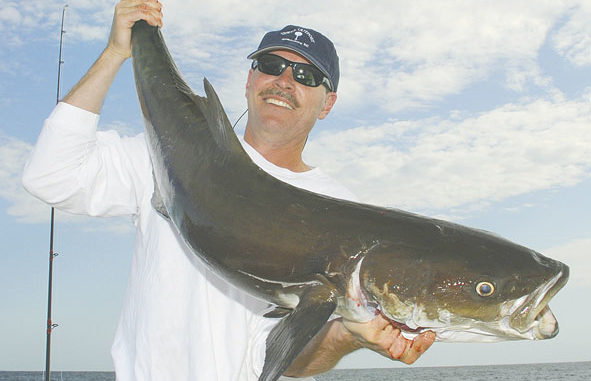
North Carolina’s Outer Banks offers fishermen great chance to sight-fish for cobia.
West of the Mississippi, much of the big-game hunting is visually oriented. Hunters are mobile, game is spotted, stalked and, if all works out, the exercise ends in a harvest.
Cobia fishing can be a lot like that. During the late spring and early summer, these fish — which are spawning — will cruise close to the surface and offer willing targets to anglers who know how to find them. Last year was a banner year for cobia fishing, especially along North Carolina’s Outer Banks.
While some anglers prefer to soak cut bait or fish live bait, others hunt the fish in sounds and nearshore waters, sight-casting to targets spotted from decks and towers. Much like casting to tailing redfish on tidal flats, it’s as much hunting as it is fishing, and two veteran cobia hunters on the Outer Banks are Hatteras guides Rick Caton and Ken Dempsey.
Caton (252-216-6765) is one of the pioneers in sight-casting to cobia. Unabashed and as salty as the water he plies, Caton runs a 42-foot boat with an add-on tower; it’s a cobia-hunting machine.
“I was casting for these (fish) 21 years before anyone else was doing it,” said Caton, who has guided since age 15. “Ninety-nine percent of what I do is sight-cast.”
Caton heads out of Hatteras Inlet and rides until he sees an area he likes, then slows down to 5 or 6 knots and starts hunting. His optics are polarized, not magnified, and his clients will be shooting jigs, not bullets. Caton keeps an eye peeled for big rays and sea turtles, as well as flotsam like boards and crates, all of which attract cobia.
“I’ll have my clients throw at ’em whether I see fish or not, mainly to sharpen their casting skills,” said Caton, who tells fishermen to cast about 20 feet in front of any cobia that’s spotted to keep from spooking it.
Caton said that many recreational anglers spook cobia before they see any.
“You got so many jackasses with outboards pushing them down,” he said.
Caton’s gear for cobia is pretty straightforward. He prefers 7½-foot, medium-action Ugly Stick rods paired with Penn Slammer 760 spinning reels that are spooled with 80-pound braid and a 4-foot shot of 80-pound fluorocarbon. Typically, a 2- or 3-ounce bucktail is on the business end, sometimes tipped with a bluefish or squid strip.
Once a fish is brought to the boat, the trip can get interesting. Cobia have a reputation for being nasty at boatside and downright dangerous if brought aboard too soon.
“I’ve killed thousands of them. You want to gaff right under the dorsal fin — amidship. A 4-inch gaff is a minimum,” said Caton. “Then, we smash ’em in the head with a 3-pound rubber mallet that is vinyl coated.”
Caton has a custom 16-foot gaff made from the top of an outrigger with a 4-inch bite that has a barb in it.
Caton has had some epic cobia hunts, and Larry Gray, owner of a clothing-store chain, annually books Caton for weeks at a time.
“Last year in a 3-day period in Hatteras, we caught 140 sight-casting, “ he said. “Twenty-seven on a Friday, 51 on a Saturday and 62 the next day — and I left ’em because my guy didn’t want to crank any more in.”
A veteran guide of 20-odd years, Dempsey guides anglers when it’s warm and duck hunters when it’s cold. He spends about 90 percent of his cobia fishing time sight-casting.
“You can catch huge fish on bait, but it’s nothing like sight-casting,” he said.
Dempsey (252-216-5581) fishes out of 23-foot boat. He does not use a tower but acknowledges the benefits of one. One of his favorite tactics is simply to find his own fishing grounds.
“I get away from the crowd,” he said. “One of the biggest mistakes people make is fishing with the other boats, by far,” he said. “Do your own thing. Get into an area and search for fish. When you see fish, they won’t be near as spooky or tower shy.”
When asked why 2010 was such a good year for cobia, Dempsey said, “That’s a hard question, but it is weather related. If that warm water — 69 to 72 degrees — is close in, we’ll have a good year. When that temperature hits 66 to 71 degrees, it was a different world.”
Dempsey uses medium-heavy Penn Power Stick rods mated to Penn Slammer 560 reels spooled with 20-pound monofilament. A 15-foot leader of 40-pound mono leads to a bucktail jig, usually 1¾ to three ounces.
“Shape is very important; you don’t want it to sink too quickly,” he said. “I use a straight bucktail 70 percent of the time. I’ll trim it with a bluefish or Spanish filet cut in a ‘V’.”
Dempsey does a have “go-to” rig for finicky fish. He keeps a lighter rod handy with 15-pound test and a half-ounce jig with a Gulp! minnow. He said it’s hard for a cobia to turn down that offering.
When Dempsey gets a fish to the boat, he always gaffs it, never using a net. He releases fish by hand. Gaffed fish come with a warning to his clients.
“I tell ’em, ‘He’s going to create some issues,’” he said. “‘I’m going to throw him in the front of the boat, and y’all are going to run to the back. We’ll let him work himself out, then throw a couple of buckets of water on him and then into the box.’”
One cobia that didn’t make home might have set Dempsey’s legacy forever, but it wasn’t meant to be.
“The biggest fish we hung in 2010 was a quarter mile out of Hatteras Inlet,” he said. “It weighed 120 pounds if it weighed an ounce.”
Dempsey had taken of group of older anglers on a trip for Spanish mackerel, and they were headed in when Dempsey saw a medium-sized cobia, which promptly ate a jig on lighter tackle. Then, the monster showed and ate another jig. They fought the two fish for 15 or 20 minutes, and then they crossed the lines, got tangled and broke off.
“I went to my knees,” Dempsey said. “My client said, ‘Ken, I don’t care.’ I said, ‘But Ken cares!’”

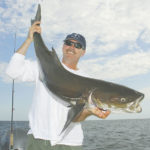
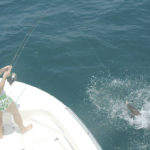
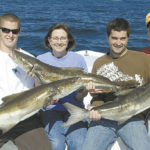
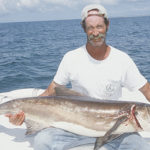
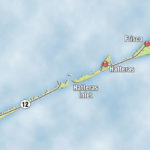
Be the first to comment